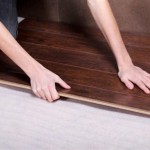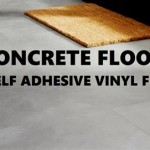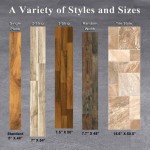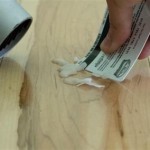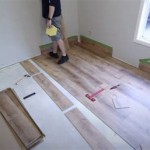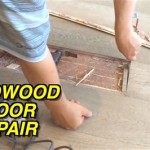Is Vinyl Plank Flooring Safe For Stairs And Landing?
The suitability of vinyl plank flooring for stairs and landings is a topic frequently debated among homeowners, contractors, and flooring specialists. Several factors influence the safety and longevity of this flooring option in these high-traffic areas, requiring careful consideration before undertaking an installation. This article will delve into the various aspects of vinyl plank flooring in relation to stairs and landings, providing a comprehensive overview of the advantages, disadvantages, and critical safety considerations.
Vinyl plank flooring, known for its durability, water resistance, and aesthetic versatility, has become a popular choice for many areas within a home. However, stairs and landings present unique challenges due to their specific requirements for slip resistance, impact resistance, and the complexity of installation. Properly addressing these factors is essential to ensuring both the short-term and long-term safety and performance of the flooring.
Understanding Vinyl Plank Flooring Composition and Types
Vinyl plank flooring is a multi-layered synthetic flooring product designed to mimic the look of natural materials such as hardwood, stone, or tile. It typically consists of several layers, each contributing to the overall performance and durability of the plank. The core layer provides structural stability, while the wear layer, the top surface, is designed to resist scratches, stains, and fading.
There are primarily two types of vinyl plank flooring: Luxury Vinyl Plank (LVP) and Waterproof Vinyl Plank (WVP). LVP flooring is generally thicker and more durable than traditional sheet vinyl, offering a more realistic appearance and texture. WVP, as the name suggests, is designed to be completely waterproof, making it an ideal choice for areas prone to moisture, though both types are often considered highly water-resistant.
The thickness of the wear layer is a critical factor in determining the durability of the vinyl plank. A thicker wear layer will provide greater resistance to wear and tear, making it better suited for high-traffic areas like stairs and landings. Wear layers are typically measured in mils (thousandths of an inch); a wear layer of 12 mils or greater is generally recommended for residential applications, while commercial applications may require 20 mils or more.
The method of installation also impacts the suitability of vinyl plank flooring for stairs and landings. Vinyl plank flooring can be installed using a variety of methods, including glue-down, click-lock, and loose-lay. Glue-down installations are generally considered the most stable and secure, making them a preferred choice for stairs. Click-lock installations, while easier to install, may be more prone to movement and separation when subjected to the constant foot traffic of stairs.
Safety Considerations for Vinyl Plank on Stairs
The primary safety concern when using vinyl plank flooring on stairs is slip resistance. Stairs, by their very nature, present a tripping hazard, and any flooring material used on stairs must provide adequate traction to prevent slips and falls. The slip resistance of a flooring material is typically measured by its Static Coefficient of Friction (SCOF). A higher SCOF indicates greater slip resistance.
Vinyl plank flooring, in its natural state, can be relatively slippery, especially when wet. Therefore, it is crucial to select a vinyl plank with a textured surface or to incorporate additional safety features such as stair treads or non-slip coatings. Stair treads are specifically designed to provide increased grip and reduce the risk of slipping. These can be installed on each step, providing a secure and comfortable walking surface.
Another important safety consideration is the proper installation of the vinyl plank. Insecurely installed planks can become loose or shift, creating tripping hazards. A glue-down installation, as mentioned earlier, is generally recommended for stairs because it provides a more secure and stable surface. The adhesive used should be specifically designed for vinyl plank flooring and should be applied according to the manufacturer's instructions.
The nose of the stair, the overhanging edge of the step, is another critical area to consider. The stair nose must be properly supported and securely attached to the underlying structure. Vinyl plank flooring can be used with a variety of stair nose profiles, but it is essential to ensure that the nose is compatible with the flooring and provides adequate support and traction. Metal or rubber stair noses are often preferred for their durability and slip resistance.
Lighting also plays a crucial role in stair safety. Adequate lighting can help to improve visibility and reduce the risk of accidents. Consider installing lights along the stairwell or incorporating lighting into the stair treads themselves. Motion-activated lights can be particularly effective, providing illumination only when needed, thus increasing safety and energy efficiency.
Advantages and Disadvantages of Vinyl Plank on Stairs and Landings
Vinyl plank flooring offers several advantages when used on stairs and landings. Its durability and water resistance make it a practical choice for high-traffic areas that are prone to spills and moisture. Vinyl plank is also relatively easy to clean and maintain, requiring only regular sweeping and occasional mopping. The aesthetic versatility of vinyl plank flooring is another significant advantage. It is available in a wide range of colors, patterns, and textures, allowing homeowners to achieve the desired look without the expense or maintenance of natural materials.
However, there are also some disadvantages to consider. As previously mentioned, vinyl plank flooring can be slippery, especially when wet. This can be mitigated by selecting a textured product or by adding stair treads or non-slip coatings. The installation of vinyl plank flooring on stairs can be more complex than installing it on a flat surface. Proper cutting, fitting, and adhering of the planks are essential to ensure a safe and durable installation. It's frequently recommended that a professional installer handle the stair application.
The cost of vinyl plank flooring can also be a factor. While vinyl plank is generally less expensive than hardwood or stone, the cost of materials and installation can still be significant, especially for a large staircase. Furthermore, lower-quality vinyl plank flooring may be prone to scratching, denting, and fading, reducing its lifespan and requiring more frequent replacement. Selecting a high-quality product with a thick wear layer is crucial to ensuring long-term performance and durability.
Another potential disadvantage is the environmental impact of vinyl plank flooring. Vinyl is a synthetic material made from petroleum-based products. The production and disposal of vinyl can contribute to pollution and greenhouse gas emissions. However, some manufacturers are now offering recycled vinyl plank flooring, which can help to reduce the environmental impact of this material. Look for products that are certified by reputable environmental organizations, such as the FloorScore certification, to ensure that they meet strict environmental standards.
The use of underlayment is an important consideration for vinyl plank flooring, especially on stairs and landings. Underlayment can provide additional cushioning, sound insulation, and moisture protection. It can also help to level out minor imperfections in the subfloor, creating a smoother and more stable surface for the vinyl plank. When installing vinyl plank on stairs, it is essential to use an underlayment that is compatible with both the flooring and the subfloor. Some underlayments are specifically designed for use on stairs, providing increased traction and support.
Ultimately, the decision of whether or not to use vinyl plank flooring on stairs and landings depends on a variety of factors, including budget, aesthetic preferences, and safety concerns. By carefully considering the advantages and disadvantages of this flooring option, homeowners can make an informed decision that meets their specific needs and priorities. Proper installation and maintenance are essential to ensuring the long-term safety and performance of vinyl plank flooring on stairs and landings.

How To Install Vinyl Plank Flooring On Stairs In 6 Steps

Luxury Vinyl Tile Seamless Upstairs And Downstairs Solution

Pros And Cons Of Installing Vinyl Flooring On Stairs Lx Hausys

Steps To Install Lvp On Stairs Flooring Insights

Pros And Cons Of Installing Vinyl Flooring On Stairs

Pros And Cons Of Installing Vinyl Flooring On Stairs Lx Hausys

An Expert Guide To Vinyl Plank Flooring For Stairs Direct Blog

Can You Install Luxury Vinyl Plank On Stairs

How To Choose Flooring For Stairs

Luxury Vinyl Tile Seamless Upstairs And Downstairs Solution
See Also
